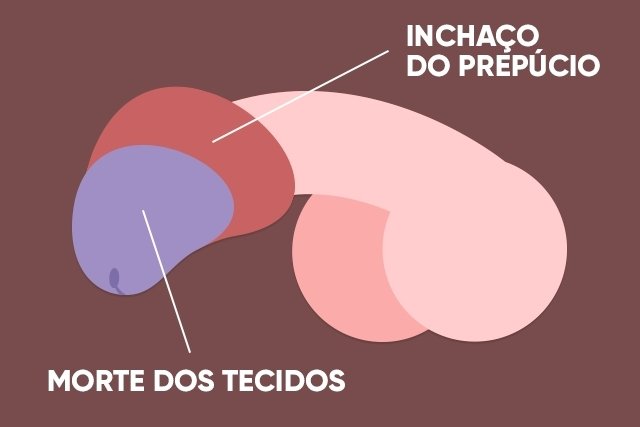Paraphimosis occurs when the foreskin becomes trapped and cannot return to its normal position, which can lead to the development of an infection or progressive necrosis of the tissues in that region.
Because it can lead to tissue death, paraphimosis is an emergency situation that must be treated as quickly as possible.
The basic treatment for paraphimosis is to cover the head of the penis with the foreskin, which may require the use of lubricating and anesthetic gel or even injectable local anesthetic.

Main symptoms
The most classic signs and symptoms of paraphimosis include:
- Swelling at the tip of the penis;
- Intense pain;
- Change in the color of the tip of the penis, which may be very red or bluish;
- Swelling and redness of the foreskin.
Normally, paraphimosis occurs in children or adolescents up to the age of 16, and is rarer in adults.
Difference Between Paraphimosis and Phimosis
Although they are similar terms, “paraphimosis” and “phimosis” define different situations. Phimosis consists of an inability, or greater difficulty, in exposing the glans, because the foreskin, which is the skin that covers it, does not have enough opening. Understand better what phimosis is, how to identify it and treatment options.
Paraphimosis is a complication that can be caused by phimosis, and occurs when the foreskin does not return to its normal position after being pulled, for example, ending up compressing the head of the penis.
Possible causes of paraphimosis
Paraphimosis occurs more frequently in boys who have phimosis or in adolescents and adults with a previous history of infection in the genital organ, direct trauma, implantation of piercing or in elderly people with a bladder catheter.
Eventually, paraphimosis may appear after sexual intercourse, when adequate hygiene of the organ is not carried out and the foreskin does not return to the correct location after flaccidity.
How the treatment is carried out
Because it can lead to necrosis/death of glans tissue, paraphimosis is an emergency situation that must be treated as quickly as possible. On the way to urological medical care, cold compresses can be applied to the area to reduce pain and swelling.
Treatment for paraphimosis varies according to the age and severity of the problem, but normally the first step consists of reducing the swelling of the penis by applying ice and covering the glans with the foreskin.
After the swelling has reduced, the skin is returned to its normal position manually, usually under anesthesia, as it can be a very painful process.
In more serious cases, the urologist may recommend emergency circumcision, where the foreskin skin is completely removed through surgery to free the penis and prevent the problem from recurring.
Bibliography
- STATPEARLS. Paraphimosis. 2021. Available at: <https://www.ncbi.nlm.nih.gov/books/NBK459233/>. Accessed on October 21, 2021
- NHS. Tight foreskin (phimosis and paraphimosis). Available at: <https://www.nhs.uk/conditions/phimosis/>. Accessed on October 21, 2021

Sign up for our newsletter and stay up to date with exclusive news
that can transform your routine!
Warning: Undefined array key "title" in /home/storelat/public_html/wp-content/plugins/link-whisper-premium/templates/frontend/related-posts.php on line 12
Warning: Undefined array key "title_tag" in /home/storelat/public_html/wp-content/plugins/link-whisper-premium/templates/frontend/related-posts.php on line 13




